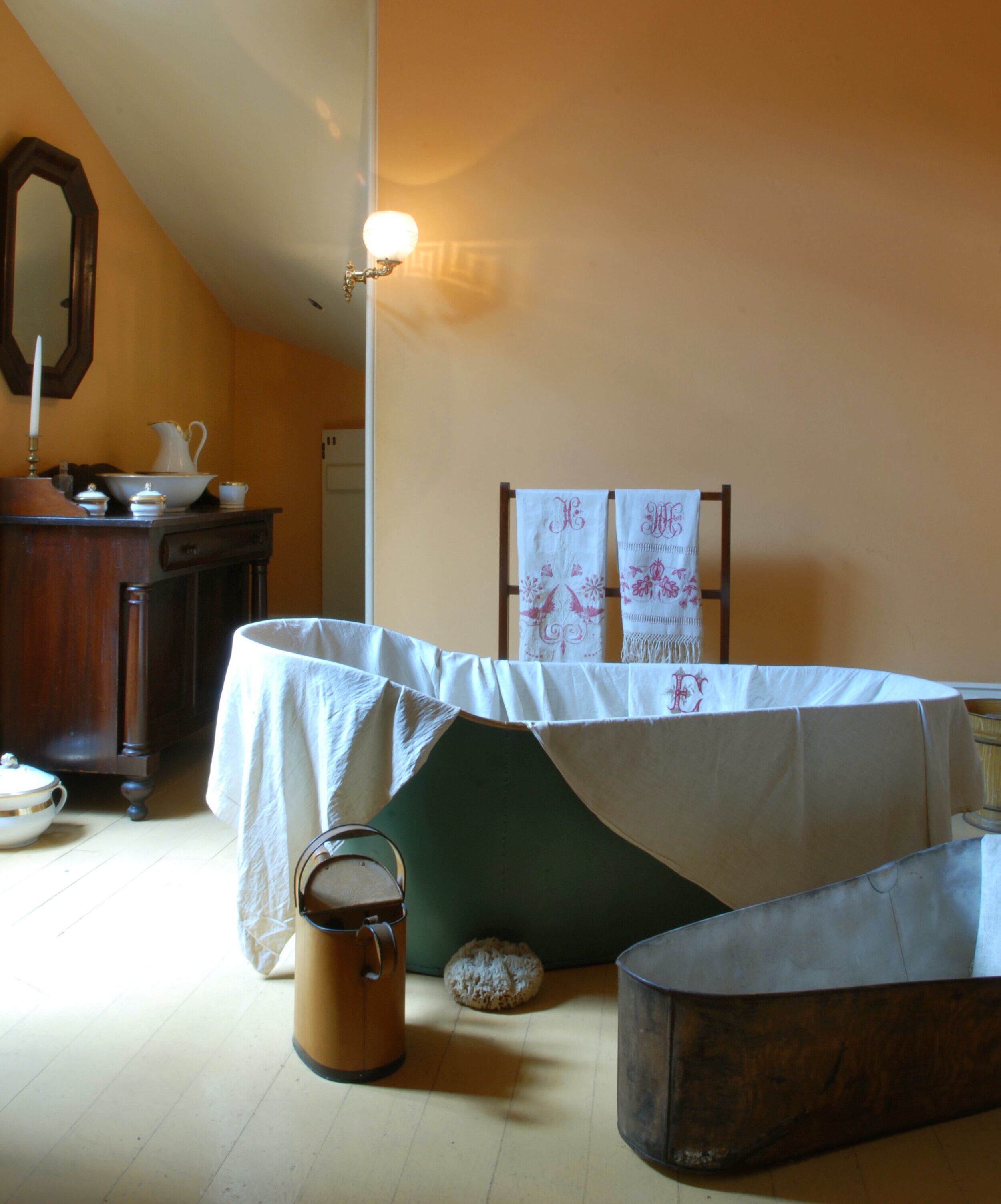The Nineteenth-Century Bathing Environment
By Bobbi Studstill
When visiting the Hermann-Grima and Gallier Historic Houses, one has the opportunity to view multiple nineteenth-century bathing environments. Visitors often are puzzled after passing through the elegant first-floor rooms of the Hermann-Grima House when they are confronted with the bathing room. This room is evidence of a contrast between the primitive and the refined in nineteenth-century New Orleans life. Yes, there is much beauty and elegance in the architecture, furnishings, clothing, and customs of the antebellum and Victorian worlds, but not all aspects of the Hermanns’ and Grimas’ lives were equally as glamorous.
The Hermann-Grima House parlor.
Imagine living through a New Orleans summer without being able to pop into a refreshing shower as desired! Imagine wearing layers of clothing and walking in filthy streets and living in houses with no air-conditioning - or even ceiling fans - as the ceilings usually held gasoliers for indoor lighting. That was a fact of 19th century life.
With no sanitation systems in New Orleans in the 19th century, the open gutters in the streets served as the sewage system. All household wastes went into these gutters. They smelled terrible and were swarming with mosquitoes and flies and were a great contributor to the diseases of the period. The public water system was nearly as primitive, with river water running through wooden or iron pipes, mostly used to irrigate the street gutters. This water was not healthy to use for drinking, cooking, or bathing. Throughout most of the 19th century the shortage of adequate water and sewage systems was the greatest obstacle to regular bathing.
The bathing room is located just off the children’s room at the Hermann-Grima House.
When Samuel Hermann built his house in 1831, indoor plumbing was not an option. He requested a small room placed in the rear of the first floor. It has two exterior doors - one open to the back gallery and the courtyard. The other open to the narrow alley between the house and the tall brick wall. The room likely never had carpeting or wallpaper. The two exterior doors would allow water to be brought in and out of the bathing room without damage to interior surfaces. The room is spacious and light, though it may have been chilly in winter, with no fireplace. As the Hermanns and Grimas were wealthy families, with a number of enslaved household staff, they could have had the luxury of “plunge” baths, fully immersing themselves in water. Preparing a full bath was quite an ordeal and probably not undertaken more than weekly. Water was taken from the cistern, heated over an open fire in the back courtyard, delivered to the large metal tub (perhaps lined with a linen sheet, to protect the body from the seams of the metal) via bucket. This large tub would require a number of trips. The bath would not be steamy hot, that was not considered healthy, especially for women. Hot baths were considered debilitating and might often lead to insanity! Until the mid–19th century, the use of soap in the bath was uncommon and considered unnecessary. Most soap, made from tallow, was specifically for washing of clothes. Only the wealthy had access to the imported and expensive perfumed toilet soaps. And yes, it is quite likely that the family shared the bath water, with warm water being added as the bathing progressed! The finished bath water would have been poured into a ditch in the alley beside the house, to run into the street gutter.
The early part of the 19th century was a period of transition, where full bathing was considered not just a medical treatment, but also a means to achieve cleanliness, a mark of moral superiority and better health amongst the middle and upper classes.
A wash basin is seen in one of the upstairs bedrooms at the Hermann-Grima House.
Trade advertisement for baths and toilet-ware made by Edward Perry, Wolverhampton m, England, 1868.
Though even wealthy families did not take a full bath daily, they were not unclean. It was the custom for most people to wash themselves in the morning, usually a sponge bath with a large washbasin and a pitcher of water on their bedroom washstands. Women might have added perfume to the water. Men often liked a cold bath in the mornings, using a basin or a smaller portable tub, followed by a brisk toweling-off. It was the custom among Creole people to provide a basin of fresh cold water, soap and towels for their guests, morning and night. In summer especially, sponge baths would have been taken as often as needed.
The hat tub is an item of interest in a bedroom in the slave quarters building at the Hermann-Grima House.
One of the most asked-about objects in tours of the Hermann-Grima House is the unusual metal tub in the enslaved woman’s room. This shallow basin with flared edges and a small platform over a drain is generally called a “hat tub”, because of its shape. An illustration from an advertisement in1868, shows the same tub (lacking the “soap dish”) labeled Parisian Sponging Bath. One might imagine the user would sit on the platform, but it is more likely the bather would stand in the tub and use the platform for a pitcher of water. Though the platform has a leg under the flared edge, sitting on it would be very precarious and require some agility! One might also sit on a stool or chair for the sponge bath, or use the tub as a medicinal foot bath.
If used by an enslaved woman, it may have been used outdoors or in the kitchen. In some households she might have been allowed to bathe in her room.
Portable tubs would have been practical for daily sponge bathing, not requiring servants or enslaved staff to heat and haul the quantity of water required for a full plunge bath
Despite advances in sanitation systems and technology, the Grima family never updated the Hermann-Grima house with plumbing or electricity. Not until the 1920’s, when the Christian Women’s Exchange purchased the house for use as a rooming house for working women, did the house become updated. A bathroom was installed on the second floor and another in the third floor attic, where six modest rooms were added for the women.
In 1859, almost 30 years after the Hermann-Grima house was built, James Gallier Jr. completed his family’s home on Royal Street. Visitors will see a huge change in sanitary technology when visiting the Gallier house! Gallier included one of the first indoor bathrooms in New Orleans, with hot and cold running water and a flushing toilet for his home.
The bathroom at Gallier House was considered very modern when it was built.
The Gallier’s bathroom on the second floor of the house features a copper bathtub and a painted porcelain toilet. The fixtures are encased in walnut-grained cabinetry, as was the fashion at the time. Cold water ran from a cistern in the attic, which was pumped daily from the large cistern in the courtyard. The cold water ran into the tub or toilet by gravity. The hot water was piped from the hot water heater attached to the kitchen range and a constant supply of hot water was available when the range was in use. It was forced through lead pipes by steam. There were also plumbed sinks in the kitchen and china pantry. One notices that there is no plumbed sink in the bathroom. With four daughters in his household, Mr. Gallier may have imagined that continuing to use bedroom washstands with basins and pitchers for sponge bathing and feminine toiletries would be more practical!
Although there was still no city sanitation service, Gallier created a septic tank in his courtyard for the household water and waste to be retained. It was cleaned regularly by “honey-dippers” who would visit the house between midnight and 4 a.m. to scoop out the septic tank (and privy) and remove the waste to a “nuisance wharf” on the river.
A hip tub in the slave quarters at 1132 Royal Street.
In Laurette’s room, in the slave quarters, is an excellent example of a hip tub. Portable tubs were still much in use in the late 19th century and onward. They were convenient, required less assistance for use. A hip tub would have allowed a more restful partial submersion than a sponge bath. One would squat in the tub or sit in it. As in using the hat tub, some agility might be required to depart from the tub without overturning it! The tub would likely have been used in the kitchen. If used in the bedroom, toweling or a rug would be needed to protect the wooden floor.
Despite the fact that the Hermann, Grima, and Galllier families and the enslaved people of their households did not have access to the bathing environments we are familiar with today, we can believe that they were still healthy and clean and followed the changing standards of socially acceptable hygiene of the 19th century.
Sources
Bushman, Richard L and Claudia L. “The Early History of Cleanliness in America.” The Journal of American History 74, No. 4 (March 1988)
Harriet Martineau, Society in America, Volume 3 (London: Sanders and Otley, Conduit Street, 1837)
Therese Oneill, Unmentionable (New York: Little Brown and Company, 2016)
David J. Overweigh, Bogs, Baths and Basins (London: The History Press, 2006)
“A Lady's Life in Mid-19th Century America “. The Exploress. https://www.theexploresspodcast.com/episodes/2018/s1e1/welcometomid19thcenturyamerica
“Health & Hygiene in Nineteenth Century England”. Museums Victoria. https://collections.museumvictoria.com.au/articles/1615
“Personal Hygiene in America” . Winterthur Museum. http://www.winterthur.org/collections/library/library-exhibitions/personal-hygiene-in-america/
“Portable Bathtubs: Tub Bathing from the Early 19th and 20th Centuries”. National Museum of American History. https://americanhistory.si.edu/collections/object-groups/portable-bathtubs-tub-bathing-from-the-early-19th-and-20th-centuries
“When Americans Started Bathing” JStor Daily. https://daily.jstor.org/when-americans-started-bathing/







